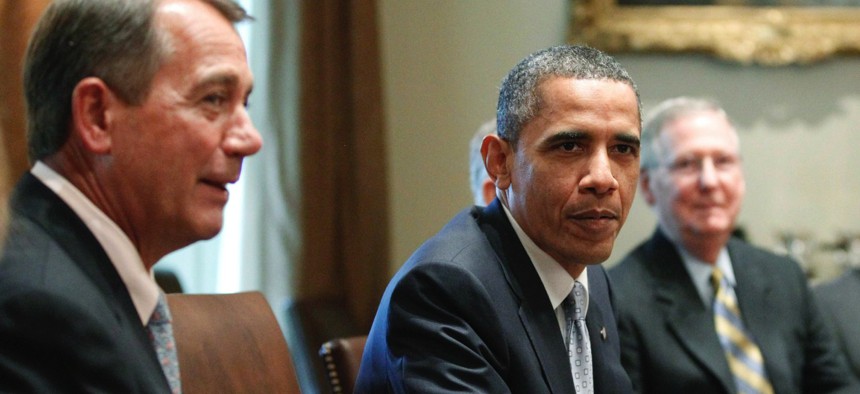‘Uncertainty Reigns’ for State Revenue as Federal Budget Showdown Looms

President Barack Obama sits with House Speaker John Boehner of Ohio, and Senate Minority Leader Mitch McConnell of Kentucky at the White House on July 13, 2011. Charles Dharapak / AP File Photo
States on average receive $1 out of every $3 of revenue from federal grants.
Last month, Congress and President Barack Obama avoided a federal shutdown by agreeing on a temporary measure to fund the government through Dec. 11. Yet it seems increasingly unlikely that a federal budget agreement will be reached without an early December budget showdown. Once again, uncertainty reigns about how much the federal government will spend even after its fiscal year has started.
This uncertainty is a particular challenge for states, which receive, on average, $1 out of every $3 of revenue from federal grants—funding that pays for health care, schools, roads, public safety, and a range of other programs.
Total federal grants to states increased by 30 percent from 2008 to 2015*, even accounting for the expiration of stimulus funds. But not all federal grants to states have fared equally under recent budget decisions—and understanding where the money goes is vital as states figure out how to fund basic necessities such as road repairs and education with a shrinking pool of federal dollars.
For while federal funding for health programs has been on the upswing, funding in almost all other areas has been on the decline.
Medicaid, which has increased by 57 percent since 2008, has been the main driver not only of the rise in federal health grants but also in the increase of all federal funds to states. A provision in the Patient Protection and Affordable Care Act expanded the program to cover previously ineligible low-income adults, with the federal government funding 100 percent of the costs through 2016 and then gradually dropping its funding level to 90 percent by 2020. This change went into effect Jan. 1, 2014, and as of September 2015, 31 states plus the District of Columbia had chosen to participate in the ACA expansion.
Meanwhile, all nonhealth grants, which include funding for K-12 education, transportation, public safety, and social services, decreased 4 percent during this same period. (See chart below.)
Given states’ requirements to balance their budgets, fluctuations in federal grants require state policymakers to make choices about adjusting their own spending in response. All of this uncertainty around federal spending is particularly challenging considering that most states are well into their current fiscal year and tax revenue in 27 states still hasn’t recovered from its plunge during the Great Recession.

See more data, charts, and analysis explaining the impact of federal fiscal decisions on states.
*All data cited from 2008-2015 are adjusted for inflation.
This analysis was originally published by The Pew Charitable Trusts's Fiscal Federalism Initiative, which is directed by Anne Stauffer.
NEXT STORY: Cities Continue to Adopt LED Street Lights





